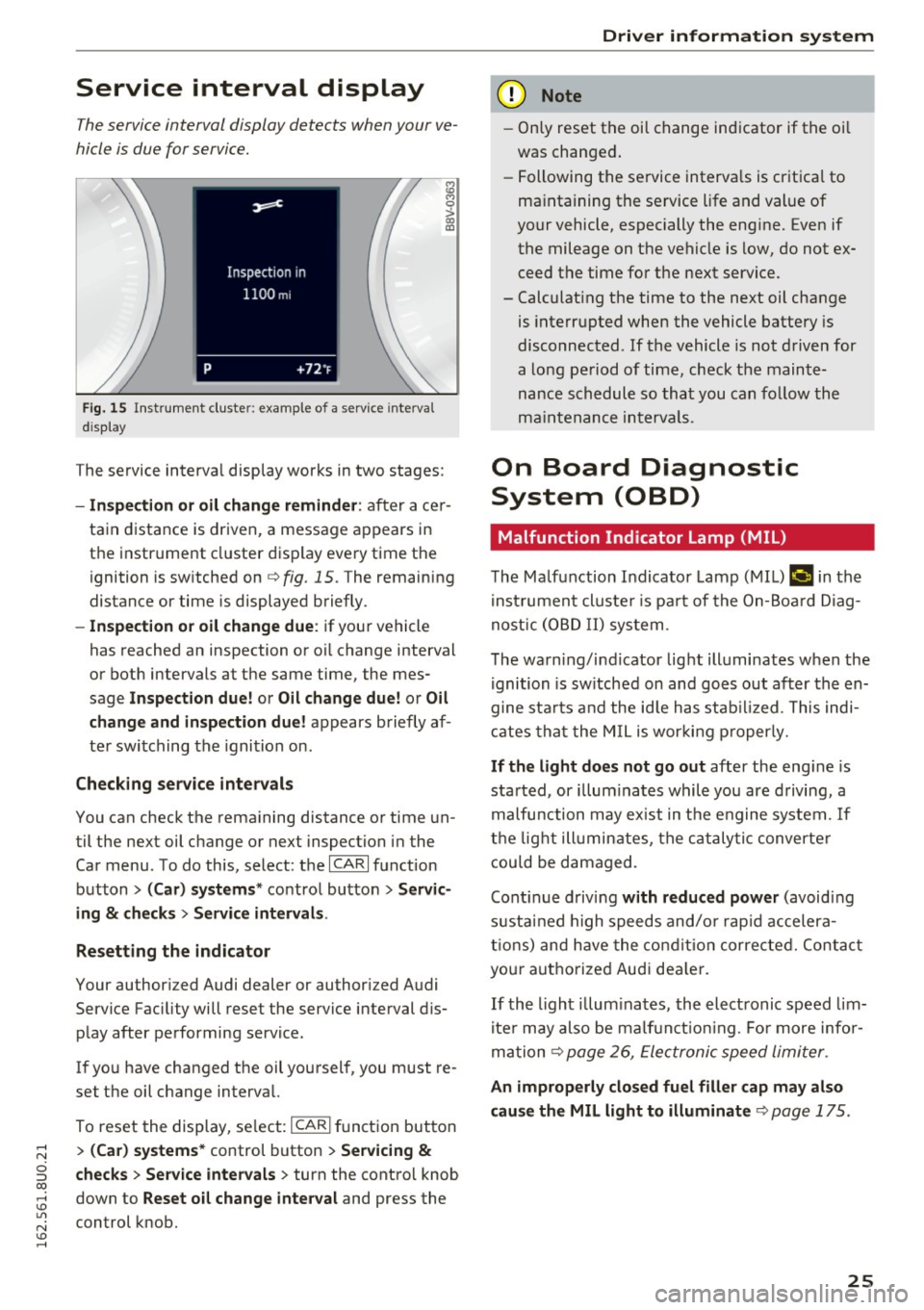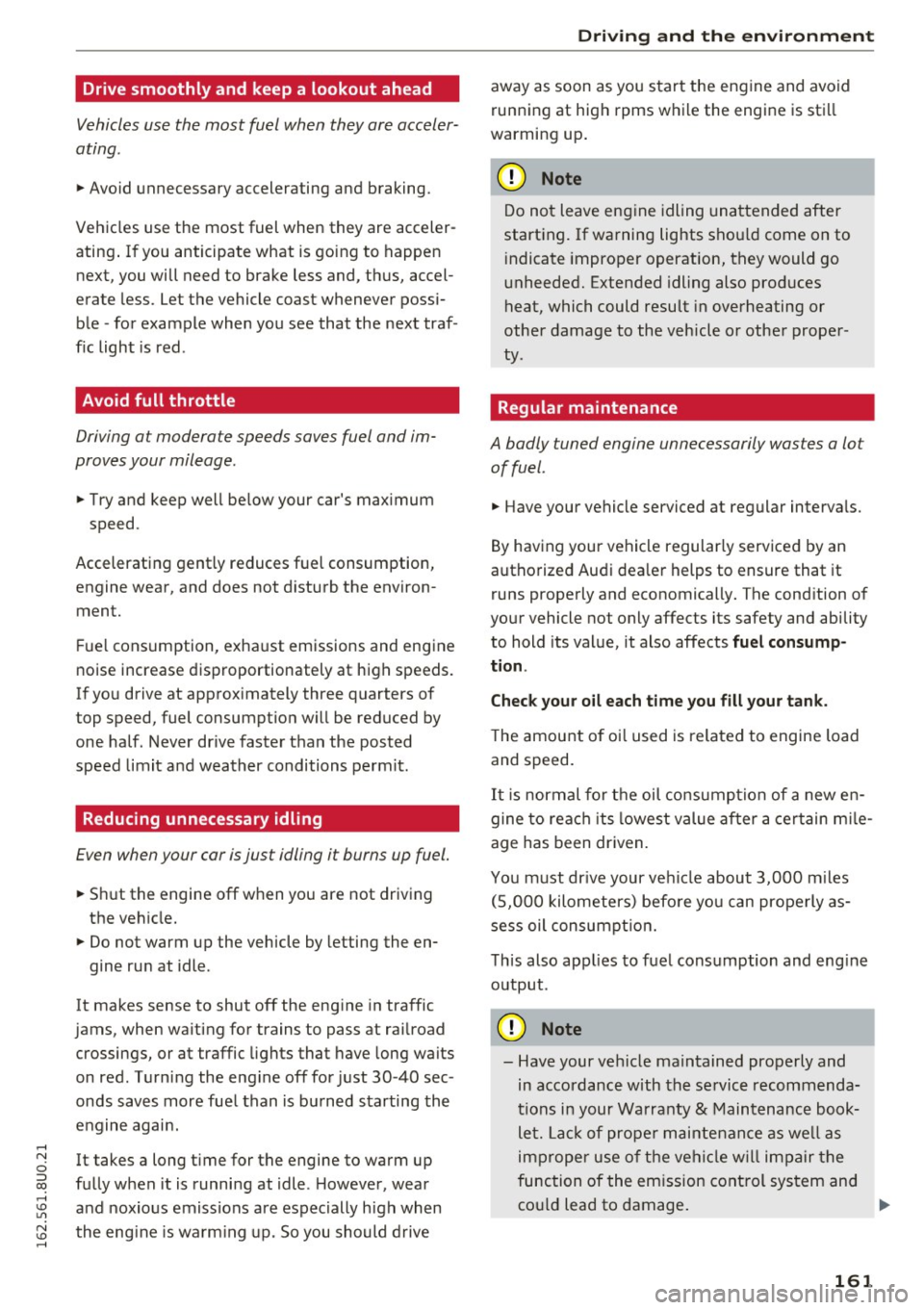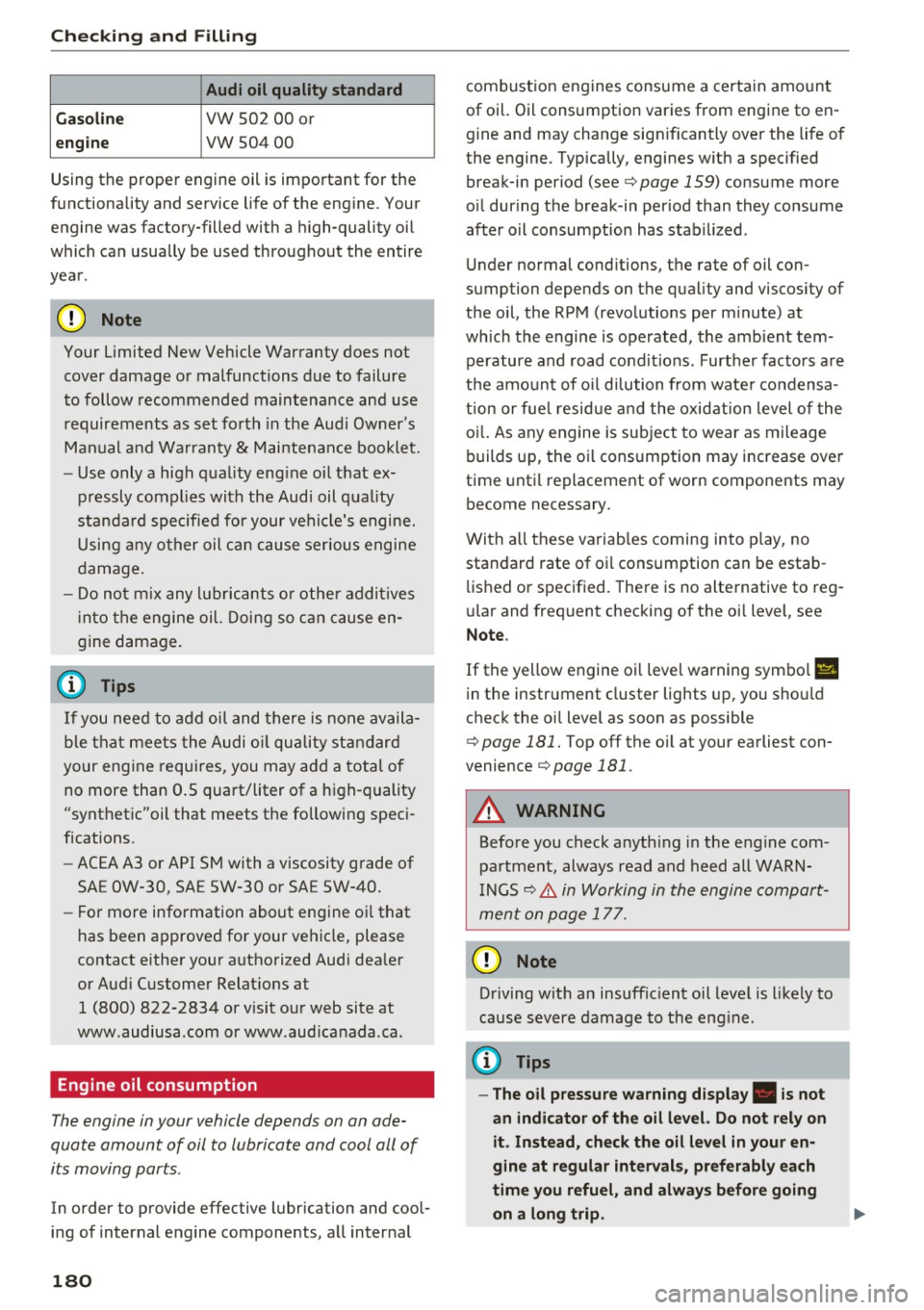mileage AUDI Q3 2016 Owners Manual
[x] Cancel search | Manufacturer: AUDI, Model Year: 2016, Model line: Q3, Model: AUDI Q3 2016Pages: 252, PDF Size: 62.81 MB
Page 27 of 252

Service interval display
The service interval display detects when your ve
hicle is due for service.
F ig. 15 I n st ru m ent cluster: example of a service interva l
d is p lay
i;i M 0
> CX) a,
The service interva l display works in two stages:
- Inspection o r oil change reminder : after ace r
ta in distance is driven, a message a ppears in
t h e instr ument cluster d isp lay eve ry time the
ignition is sw itched on
q fig. 15 . The remain ing
distance or time is displayed briefly.
-Inspection or oil change due : if your vehicle
has reached an inspection or o il change interval
or both intervals at the same time, the mes
sage
Inspection due! or Oil change due! or Oil
change and in spection due!
appears brie fly af
te r swi tching the igni tion on.
Check ing service intervals
You can check the rema ining distance or time un
til the next oil change or next inspection in the
Car menu. To do this, select: the
I CA RI fu nction
button
> (Car) systems * contro l bu tton > Servic
ing
& checks > Service intervals .
Resetting the indicator
Your author ized Audi dealer or author ized Audi
Service Faci lity will reset the service interval dis
p lay after pe rforming service.
If yo u have changed the oil you rsel f, you must re
set the oil change interva l.
To reset the display, se lect:
I CARI fu nct ion but ton
> (Car) systems * control button > Servicing &
checks > Service intervals > turn the cont ro l knob
down to
Reset o il change interval and press the
control knob.
Driver information system
(D Note
- Only reset the oi l ch ange ind icator if the oi l
was changed.
- Following the se rvice interva ls is cr it ica l to
ma intaining the se rvice life and value of
yo ur vehicle, especially the eng ine. Even if
the mileage on t he ve hicle is low, do not e x
ceed the time fo r the next service.
- Calculat ing the time to the next oil change
is inte rru pted when the vehicle battery is
disconnected . If the vehicle is not d riven for
a lo ng pe riod of time, check t he main te
nance schedule so tha t you can fo llow the
maint enance in terva ls.
On Board Diagnostic
System (OBD)
Malfunction Indicator Lamp (MIL)
The M alfunction Indicator Lamp ( MIL) ¢'4 in the
i nst ru m en t cl uste r is p art o f the On-Boa rd Di ag
n os tic ( OBD I I) system .
T he wa rn ing/i nd icator lig ht ill uminates w hen the
ignition is sw itch ed on and goes out after th e en
gine sta rts and the id le h as stab ilized. This indi
ca tes tha t the M IL is wor kin g p roperly.
If the light does not go out after the eng ine is
sta rted, or illum inates while you are d riving, a
malfu nction may ex ist in the e ngine sys tem. If
t h e lig ht illumin ates, the c ata ly tic converte r
cou ld be d amaged.
Cont inue d riv in g
with reduced power (avoid ing
s u st ain ed high speeds and/o r rap id accelera
ti ons ) and have the co nditi on corre cte d. Cont act
yo ur aut ho rize d Aud i dea le r.
If th e li ght il lum inates, the ele ct ronic speed lim
i te r may also be ma lf u nct io ni ng. Fo r more inf or
m at ion
q page 26, Ele ct ronic speed limi ter.
An improperly closed fuel filler cap may also
cause the MIL light to illuminate
q page 175.
25
Page 163 of 252

Drive smoothly and keep a lookout ahead
Vehicles use the most fuel when they are acceler
ating .
11-Avoid unnecessary accelerating and braking.
Vehicles use the most fuel when they are acceler ating . If you anticipate what is going to happen
next, you will need to brake less and, thus, accel
erate less . Let the vehicle coast whenever possi
ble - for example when you see that the next traf
f ic light is red .
Avoid full throttle
Driving a t modera te speeds saves fuel and im
proves your mileage .
11-Try and keep well be low your car's max imum
speed.
Accelerating gent ly reduces fuel consumption,
engine wear, and does not disturb the environ
ment.
F ue l cons umption, exha ust emissions and engine
noise increase disproportionately at high speeds.
If you drive at approximately three quarters of
top speed, fuel consumpt ion will be reduced by
one half. Never drive faster than the posted
speed limit and weather conditions permit.
Reducing unnecessary idling
Even when your car is just idling i t burns up fuel.
11-S hut the engine off w hen you are not driving
the vehicle.
11-Do not warm up the vehicle by letting the en-
gine ru n at idle .
It makes sense to shut off the eng ine in traffic
jams, when wa iting for trains to pass at rai lroad
crossings, or at traffic lights that have long waits
on red . Turn ing the eng ine off for just 30 -40 sec
onds saves more fue l than is bu rned starting the
engine agai n.
It takes a long t ime for the engine to warm up
fu lly when it is runni ng at idle . However, wear
and noxious emiss ions are especially high when
the eng ine is wa rm ing up . So you should d rive
Driving and the envir onment
away as soon as you start the eng ine and avoid
running at high rpms w hil e the engine is sti ll
warming up .
(D Note
Do not leave eng ine idling una ttended after
starting. If wa rning lights shou ld come on to
i ndicate improper operation, they would go
unheeded. Extended idling also prod uces
heat, which could result in overheating or
other damage to the vehicle or other proper
ty .
Regular maintenance
A badly tuned engine unnecessarily wastes a lot
of fuel .
11-Have your vehicle serviced at regular interva ls.
By having your vehicle regular ly serv iced by an
authorized Audi dea ler helps to ensure that it
runs properly and economically. The cond ition of
your vehicle not only affects its safety and ability
to hold its value, it also affects
fuel con sump
tion .
Chec k your oil each t ime you fill your tank.
T he amount o f oi l used is related to engine load
and speed.
It is normal fo r the oil consump tion of a new en
gine to reach its lowest value after a ce rtain m ile
age has been dr iven.
You m ust dr ive your ve hicle about 3,000 m iles
(5,000 kilometers) befo re yo u can prope rly as
sess oil consumpt io n.
T h is also app lies to fuel consumption and eng ine
output.
(D Note
- Have your vehicle maintained properly and in accordance with the se rvice recommenda
tions i n your Warranty
& M aintenance book-
le t. La ck of prope r maintenan ce as we ll as
imp roper use of the ve hicle will im pair the
function of the em ission cont rol sys tem and
co uld lead to damage . .,.
161
Page 182 of 252

Check ing and F illing
Audi oil quality standard
Gas olin e
VW 502 00 or
engi ne vw 50400
Using the proper engine oil is important for the
functionality and service life of the engine. Your
engine was factory-filled with a high-quality oil
which can usually be used throughout the entire
year .
Q) Note
Your Limited New Vehicle Warranty does not
cover damage or malfunctions due to failure
to follow recommended maintenance and use
requirements as set fo rth in the Audi Owner's
Manual and Wa rranty
& Maintenance booklet.
- Use only a high qua lity eng ine oi l th at ex-
pressly complies with the Audi oil qua lity
stan dard specified for your vehi cle's engine.
Using any o ther oil can cause serious engine
damage .
- Do not mix any lubricants o r other addit ives
i nto the engine oil. Doing so can cause en
gine damage.
(D Tips
I f you nee d to add oi l and there is none availa
ble that meets the Audi o il qu ality st andard
your engine requires, you may ad d a total of
no more than 0 .5 quart/liter of a high-quality
"synthet ic"oil that meets the following speci
fications.
- ACEA A3 o r API SM with a viscosity g rade of
SAE OW-30, SAE 5W-30 or SAE 5W-40.
- For more information about engine oi l that
has been approved for your vehicle, please
contact either your authorized Audi dea ler
or Audi Custome r Relat ions at
1 (800) 822-2834 or visit our web site at
www.audiusa.com or www .aud icanada .ca.
Engine oil consumption
The engine in your vehicle depends on an ade
quate amount of oil to lubricate and cool all of
its moving parts .
In order to provide effective lubrication and cool
ing of internal engine components, all internal
180
combust ion engines consume a certa in amo unt
of oil. Oil consumption varies from engine to en
gine and may change significantly over the life of
the engine. Typically, engines w ith a specified
break-in period (see
c:::;, page 159) consume more
o il dur ing the break-in per iod than they consume
af ter o il consumption has stab ilized .
Under normal conditions, the rate of oil con
sumption depends on the quality and viscos ity of
the oil, the RPM (revo lutions per m inute) at
wh ich the engine is operated, the amb ient tem
perature and road condit ions. Further factors a re
the amount of o il di lution from wate r co ndensa
tion or fue l resid ue an d the oxidation level of the
o il. As any engine is sub ject to wear as mileage
builds up, the oi l cons umption may increase over
time unt il replacement of worn components may
become necessary.
With a ll these variab les coming into p lay, no
standard rate of oil consumption can be estab
li shed or specified. The re is no alternative to reg
u lar and frequent checking of the oi l level, see
Note.
If the yellow engine oil level warning symbo l Ell
in the instrument cluster lights up, you sho uld
check the oil level as soon as possible
c:::;, page 181. Top off the oil at your earliest con
venience
c:::;,page 181.
A WARNING
Before you check anyth ing in the e ng ine com
partment, always read and heed all WARN
I NGS
c:::;, .&. in Working in the engin e compart
ment on page 177.
(D Note
Driving w ith an insuffic ient oil level is likely to
cause severe damage to the eng ine.
(D Tips
- The oil pressure warn ing d isplay. is not
an indicator of the oil level. Do not rely on
it. Instead, check the oil level in your en
g ine at regular int ervals , pr eferably each
time you refuel, and alway s before going
on a long trip .